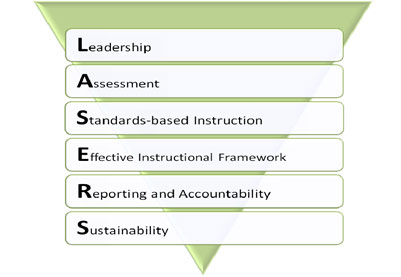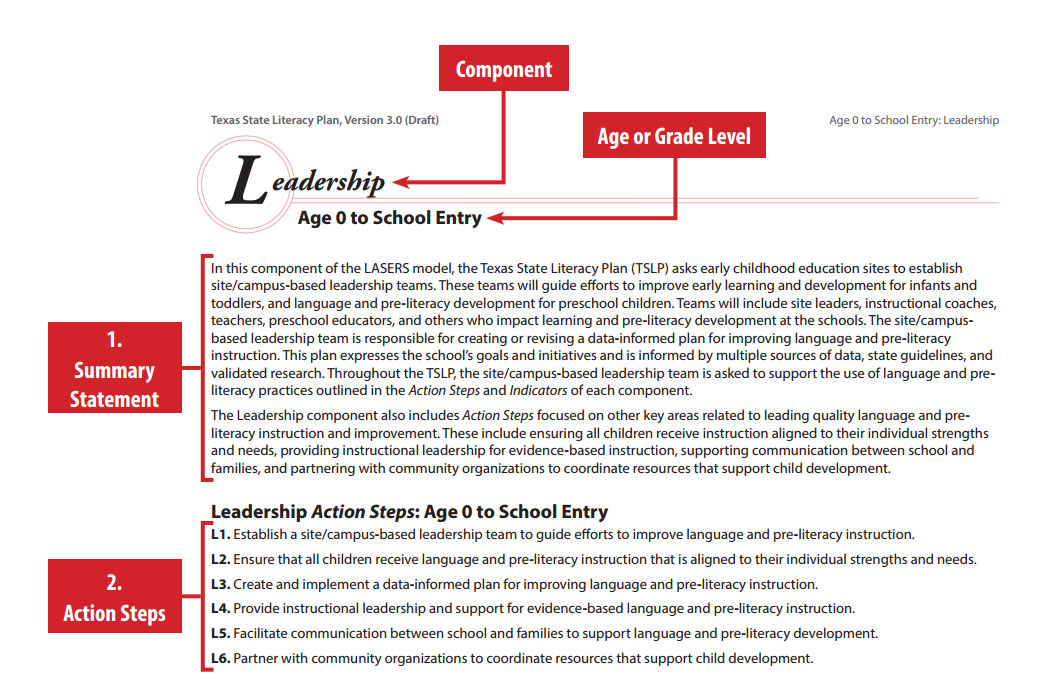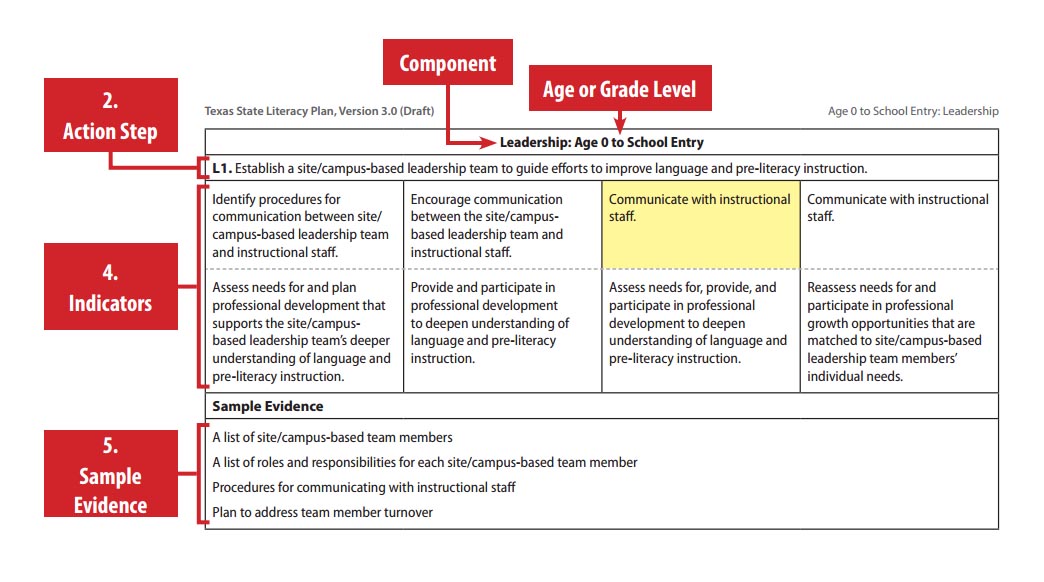Orientation
Welcome to the Texas State Literacy Plan Online Course.
This lesson is designed to familiarize you with the Texas State Literacy Plan (TSLP) and related tools you will use in this online course. This lesson also provides an overview of the organization of the course.
To review the rest of the lesson content, click on the section titles in the left hand margin.
Part 1—Introduction to the Texas State Literacy Plan
The purpose of the Texas State Literacy Plan is to guide school and district leaders in school-wide efforts to improve reading and writing outcomes for students. The TSLP provides a comprehensive description of the practices and systems needed to reach this goal at three age and grade levels—Age 0 to School Entry, Kindergarten through Grade 5, and Grades 6 through 12.
The Plan is organized into a framework of six essential components:

Increasing capacity in these six areas is necessary to ensure the success of the next generation of college- and career-ready Texans.
Each component of the TSLP includes the following:
- Summary Statement: A summary statement for each of the LASERS components is provided at the beginning of the Implementation Guide in each of the age/grade levels.
- Action Steps: Each component of the TSLP is comprised of a set of key Action Steps at each age/grade level grouping. While you will, of course, want to coordinate with state- and district-level actions in support of literacy, the Action Steps in the TSLP can support your implementation at the site or campus level. These Action Steps are numbered but are not meant to be implemented in sequential order.
- Implementation Status Ratings: The Implementation Status Ratings provided for each Action Step are adapted from Fixen, Naoom, Blase, Friedman, & Wallace (2005). In the online course, these are also referred to as implementation levels.
- Implementation Indicators: These Indicators further explain the Action Step by describing what practices and systems are being planned or taking place at the different levels of implementation. Sites and campuses use the Indicators as a guide during self-evaluation and when developing plans of action during implementation of the TSLP Action Steps.
- Sample Evidence: Sample Evidence for the implementation of Action Steps is listed below the Implementation Indicators. The samples might include agendas, sign-in sheets, or lesson plans. Samples are intended to serve as guides and should not be considered an exhaustive list.

(Click on the image above to see a larger version.)

(Click on the image above to see a larger version.)
You can download a copy of the TSLP here. The three-page guide illustrating the organization is downloadable here.
The TSLP Implementation Guides are also available by age/grade level (without the Introduction, Appendices, and Glossary that are included in the full version).
Part 2—Self-Assessing with the Implementation Inventory
The Implementation Inventory is a tool for use at the site or campus level for self-assessment of the components of the TSLP. Assessing your current level of progress is the first step in using the TSLP to improve your school’s literacy instruction and is an integral part of taking the TSLP online course. You can use the results to prioritize your efforts in implementing the TSLP.
To complete the Implementation Inventory, each site- or campus-based leadership team will rate its current level of implementation for each Action Step in the TSLP.
To rate your implementation level for an Action Step, it may be useful for you and your team to first consider what Full Implementation with Fidelity (Level C) looks like and determine if this describes what is currently in place at your site or campus. You might next look back at Levels A and B and then look forward to Level D to gain a broader understanding of the range of implementation and where your site/campus might currently fall with regard to an Action Step. The Implementation Inventory will be most useful to you when it is as close to a true representation of your current status as possible.
The Implementation Inventory is designed to be completed by a team so that the assessment shows the result of group discussion and reflection on the literacy work currently happening at your site or campus. You will need to establish meeting times to have these discussions. You may also want to look through the TSLP individually to familiarize yourself with the Indicators and Sample Evidence that will help your team select the appropriate level for your school with regard to each Action Step.
The TSLP Implementation Status Ratings resource is a printable handout describing each of the four status ratings. Your team will need to download the Implementation Guide in the first lesson of each module and use a pencil to rate your current level of performance. By using a pencil, your team can adjust your rating as progress is made.
TSLP Implementation Status Ratings 0–SE
TSLP Implementation Status Ratings K–5
TSLP Implementation Status Ratings 6–12
Part 3—Organization of the Course
The TSLP online course is designed to be taken by a team of leaders at a site or campus. Throughout the TSLP and the course, this team is called the site-based leadership team (Age 0 to School Entry) or campus-based leadership team (Kindergarten through Grade 5, and Grade 6 through 12). This team might be formed for the purpose of using the TSLP and the online course to guide improvement initiatives or might be an existing group, such as a campus-based team or committee focused on school improvement efforts that include literacy instruction. In either case, the team should be comprised of administrators, teachers, and other stakeholders who are informed about and involved in literacy instruction. More information about site- and campus-based leadership teams can be found in lesson L1—Site/Campus-based Leadership Teams.
For each age/grade level, you will find seven modules—one for each of the LASERS components of the TSLP and one on Implementation of the TSLP. Each LASERS module has lessons that explain the Action Steps of the component. The purpose of each lesson is to explain the key elements of a particular Action Step and provide resources for leadership teams to explore further. The lessons average about 2500 words, with a few lessons closer to 1200 and a few about 5000 words.
Within each lesson, you find the following sections:
Action Step: Lists the Action Step(s) the lesson focuses on,
Orientation: Outlines what information is provided in the lesson,
Part 1–3: Describes and explains key elements of the Action Step(s),
Assignment: Directs participants to the reflective task and resources for completing it, and
References: Lists sources used in creating the lesson content
Each lesson has Part 1 and Part 2 content; some lessons also have Part 3. Links included in the content—in Parts 1–3—should be reviewed as part of the reading of the lesson.
Some additional features in the lesson are as follows:
Scenarios: A narrative description of the Action Step or Indicators being put in place in a school context, used to illustrate the content of the lesson
To Learn More: A list of resources that support further exploration of the topic of the lesson or tools for implementation; these resources might be reviewed during participation in the lesson or at a later time.
Next Steps: A list of suggested actions a leadership team might take when ready to focus their efforts on that Action Step, depending on their level of implementation at the time
The Implementation module is structured differently from the LASERS modules. This module illustrates a cyclical six-step process for leadership teams to use in implementing literacy improvement plans based on the TSLP. This module can be used with any component of the TSLP and can be repeated as your team focuses on different areas of improvement over time.
Assignment
In this section, you will find the link to the Assignment document for the lesson. The assignment is a reflection task that is the same for most of the LASERS lessons (with the exception of a few lessons in the Assessment 0–SE module). The task is to reflect on the implementation level of your site or campus for the Action Step and to identify some next steps you might take when you are ready to focus your improvement efforts on the Action Step.
You may or may not be taking on that work at the same time you are engaging in the TSLP online course lesson. If your team were working to complete a module in a semester, for example, you would not be able to initiate and sustain active work on four to six different areas of improvement (Action Steps) at the same time. The assignment guides your team to reflect on what is needed as you discuss the content of each lesson so that you can record your best ideas for next steps and refer back to the completed assignment when you decide to work on the Action Step as a school.
Reference
Fixsen, D. L., Naoom, S. F., Blase, K. A., Friedman, R. M., & Wallace, F. (2005). Implementation research: A synthesis of the literature (FMHI Publication 231). Tampa, FL: University of South Florida, Louis de la Parte Florida Mental Health Institute, The National Implementation Research Network.
